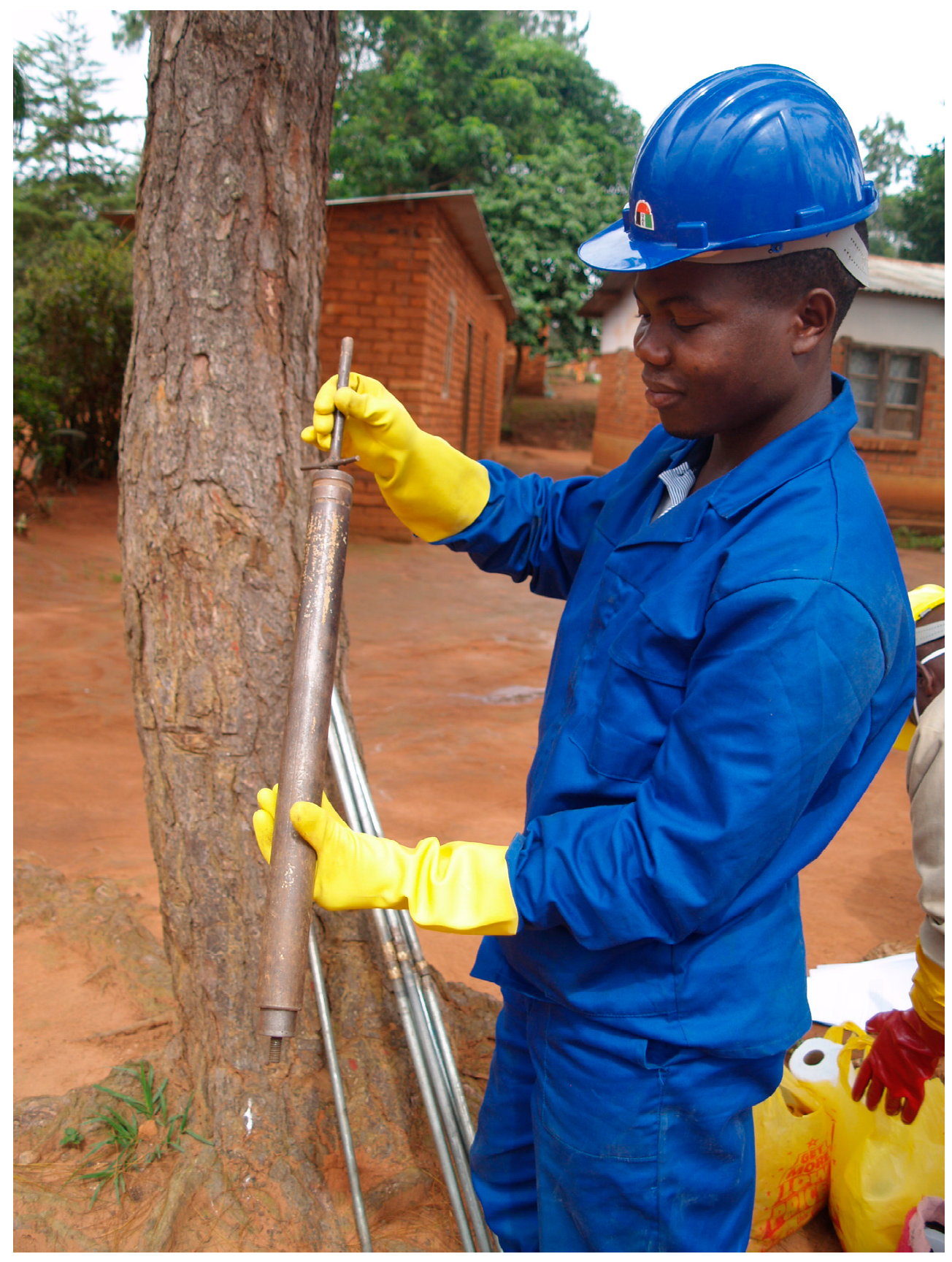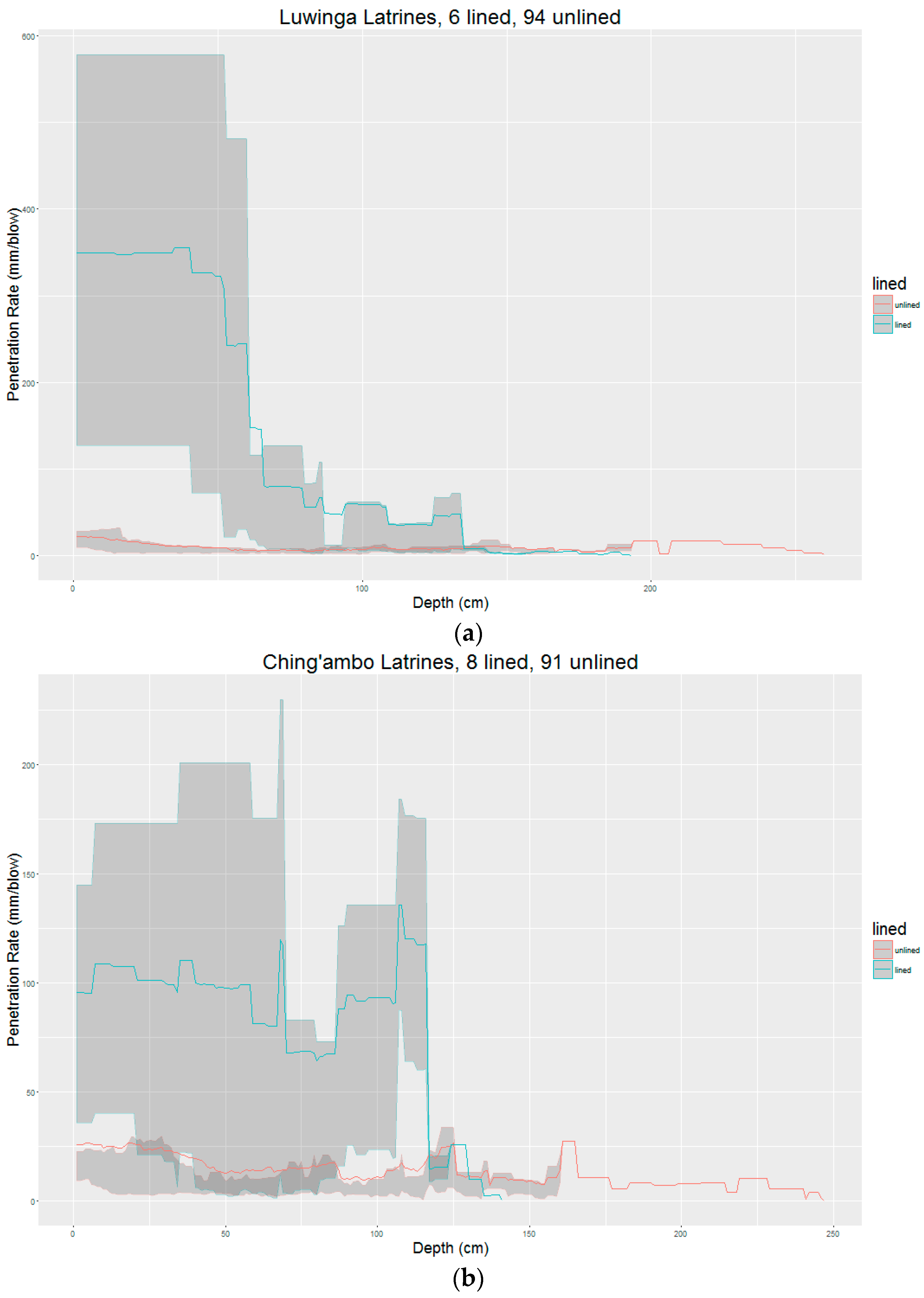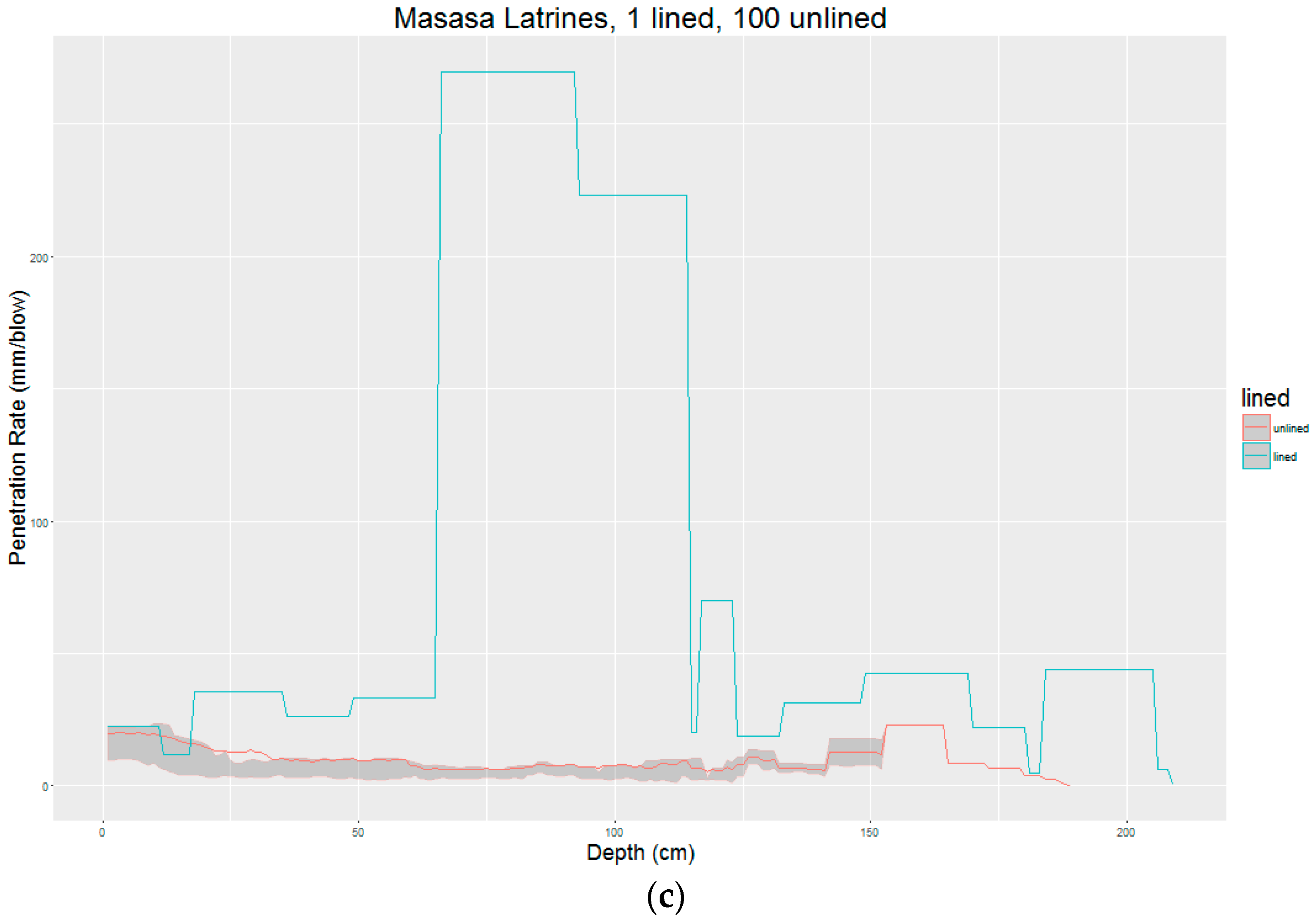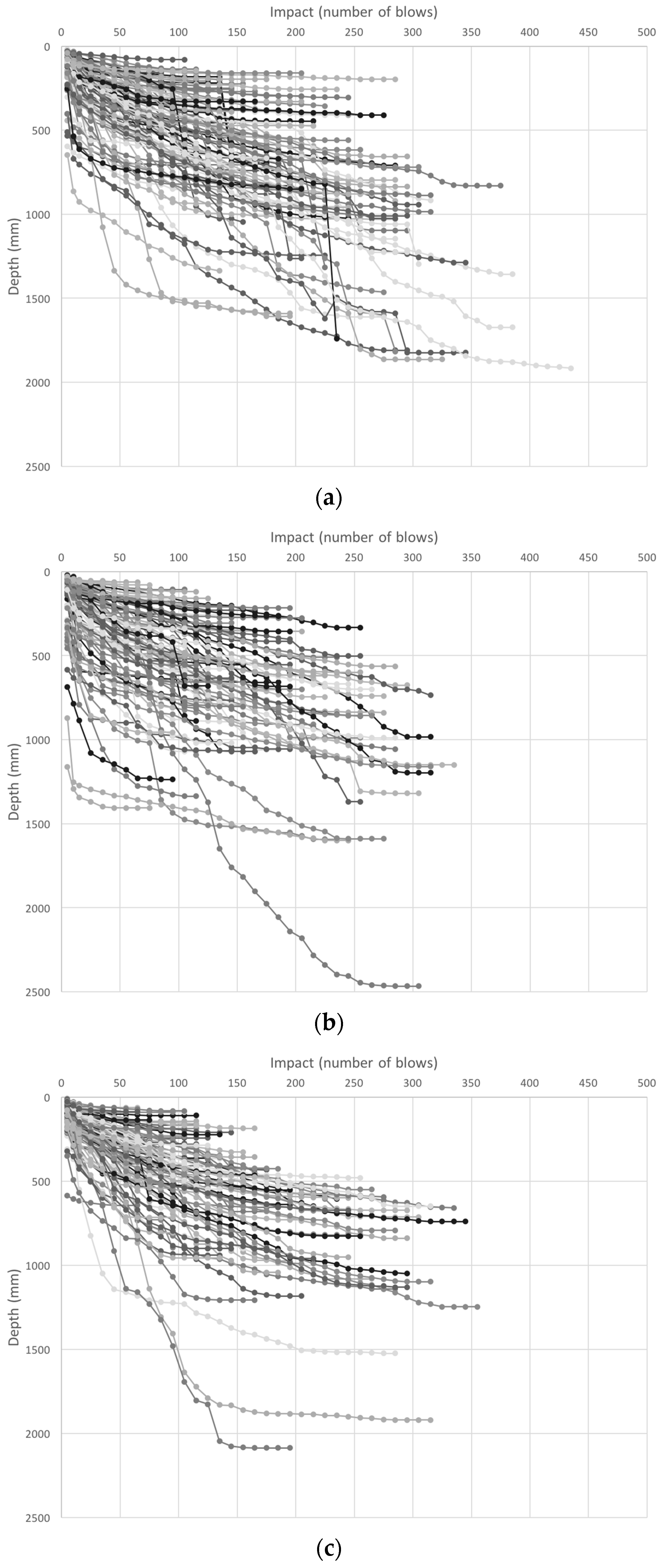Pit Latrine Fecal Sludge Resistance Using a Dynamic Cone Penetrometer in Low Income Areas in Mzuzu City, Malawi
Abstract
:1. Introduction
2. Materials and Methods
2.1. Assessment of Household Sanitation Practices
2.2. Assessment of Sludge Strength
3. Results
3.1. Household Sanitation Practices
3.2. Sludge Strength Results
3.2.1. Impact-Based Analysis
3.2.2. Penetration Resistance
3.2.3. Depth Effect Analysis
4. Discussion
5. Conclusions
Acknowledgments
Author Contributions
Conflicts of Interest
References
- Strande, L.; Ronteltap, M.; Brdjanovic, D. Faecal Sludge Management Systems Approach for Implementation and Operation. Available online: http://www.eawag.ch/en/department/sandec/publikationen/faecal-sludge-management-fsm-book/ (accessed on 26 April 2016).
- Semiyaga, S.; Okureb, M.A.E.; Niwagabaa, C.B.; Katukiza, A.Y.; Kansiime, F. Decentralized options for fecal sludge management in urban slum areas of Sub-Saharan Africa: A review of technologies, practices and end-uses. Resour. Conserv. Recycl. 2015, 104, 109–119. [Google Scholar] [CrossRef]
- Radford, J.T.; Fenner, R.A. Characterization and fluidization of synthetic pit latrine sludge. J. Water Sanit. Hyg. Dev. 2013, 3, 375–382. [Google Scholar] [CrossRef]
- Bakare, B.F.; Foxon, K.M.; Brouckaert, C.J.; Buckley, C.A. Variation in VIP latrine sludge contents. Water SA 2012, 38, 479–486. [Google Scholar] [CrossRef]
- Mohammadi, S.D.; Nikoudel, M.R.; Rahimi, H.; Khamehchiyan, M. Application of the dynamic cone penetrometer (DCP) for determination of the engineering parameters of sandy soils. Eng. Geol. 2008, 101, 195–203. [Google Scholar] [CrossRef]
- Radford, J.T.; Sugden, S. Measurement of fecal sludge in-situ shear strength and density. Water SA 2014, 40, 183–188. [Google Scholar] [CrossRef]
- Seal, D. Identifying Appropriate Pit-Emptying Technologies in a Nairobi Slum—Based on Sludge Characteristics and Access. Master’s Thesis, Cranfield University, Cranfield, UK, 2012. [Google Scholar]
- Thye, Y.P.; Templeton, M.R.; Ali, M. A critical review of technologies for pit latrine emptying in developing countries. Crit. Rev. Environ. Sci. Technol. 2011, 41, 1793–1819. [Google Scholar] [CrossRef]
- Holm, R.H.; Tembo, J.M.; Thole, B. A comparative study of fecal sludge management in Malawi and Zambia: Status, challenges and opportunities in pit latrine emptying. Afr. J. Environ. Sci. Technol. 2015, 9, 783–792. [Google Scholar]
- Mzuzu City Council. Urban Profile 2013–2017; Ministry of Local Government: Mzuzu, Malawi, 2013.
- D6951/D6951 M-09 Standard Test Method for Use of the Dynamic Cone Penetrometer in Shallow Pavement Applications. Available online: www.astm.org (accessed on 8 September 2016).
- Nakagiri, A.; Kulabako, R.N.; Nyenje, P.M.; Tumuhairwe, J.B.; Niwagaba, C.B.; Kansiime, F. Performance of pit latrines in urban poor areas: A case of Kampala, Uganda. Habitat Int. 2015, 49, 529–537. [Google Scholar] [CrossRef]
- Murungi, C.; Van Dijk, P.M. Emptying, transportation and disposal of fecal sludge in informal settlements of Kampala Uganda: The economics of sanitation. Habitat Int. 2014, 42, 69–75. [Google Scholar] [CrossRef]
- Chipeta, W. Pedal Modification on Gulper Pump Technology for Pit Latrine Emptying in Peri Urban Mzuzu (Malawi). Master’s Thesis, Mzuzu University, Mzuzu, Malawi, 2016. [Google Scholar]
- Jenkins, M.W.; Cumming, O.; Cairncross, S. Pit latrine emptying behaviour and demand for sanitation services in Dar es Salaam, Tanzania. Int. J. Environ. Res. Public Health 2015, 12, 2588–2611. [Google Scholar] [CrossRef] [PubMed]
- Obeng, P.A.; Keraita, B.; Oduro-Kwarteng, S.; Bregnhøj, H.; Abaidoo, R.C.; Awuah, E.; Konradsen, F. Usage and barriers to use of latrines in a Ghanaian peri-urban community. Environ. Process. 2015, 2, 261–274. [Google Scholar] [CrossRef]
- Kimuli, D.; Zziwa, A.; Banadda, N.; Kabeng, I.; Kiggundu, N.; Kambugu, R.; Wanyama, J.; Tumutegyereize, P.; Kigozi, J. Quantification of physico-chemical characteristics and modeling faecal sludge nutrients from Kampala city slum pit latrines. Int. J. Res. Eng. Adv. Technol. 2016, 3, 129–141. [Google Scholar]
- Buckley, C.A.; Foxon, K.M.; Brouckaert, C.J.; Rodda, N.; Nwaneri, C.; Balboni, E.; Couderc, A.; Magagna, D. Scientific Support for the Design and Operation of Ventilated Improved Pit Latrines (VIPs) and the Efficacy of Pit Latrine Additives; Report No. TT357/08; Water Research Commission: Pretoria, South Africa, 2008. [Google Scholar]





| Characteristic | Response Categories | Luwinga (n = 100) | Ching’ambo (n = 99) | Masasa (n = 101) |
|---|---|---|---|---|
| Religious affiliation | Christianity | 100% | 98% | 97% |
| Muslim | - | 2% | 3% | |
| Household incidence of diarrhea within the past seven days | No | 84% | 89% | 93% |
| Yes | 16% | 11% | 7% | |
| Household waste management practices | In the pit latrine | 1% | - | - |
| In water | - | 1% | 3% | |
| Rubbish pit | 95% | 81% | 70% | |
| Surface | 4% | 18% | 27% | |
| Time over which the latrine has been in use | >2 Years | 65% | 81% | 71% |
| 1–2 Years | 30% | 19% | 29% | |
| <1 year | - | - | - | |
| Unknown | 5% | - | ||
| Method used for anal cleansing | Toilet paper/tissue only | 14% | 11% | 9% |
| Any materials other than toilet paper/tissue or water | 86% | 87% | 90% | |
| Water | - | 2% | 1% | |
| Sharing of the latrine facility with other households | Not shared | 49% | 35% | 40% |
| Shared | 51% | 65% | 60% | |
| Household option in case of a full pit latrine | Call emptying service | 15% | 17% | 3% |
| Dig another pit | 80% | 80% | 96% | |
| Use chemicals | 2% | 2% | - | |
| Use neighbor’s latrine | 3% | 1% | 1% | |
| Household knowledge of pit latrine sludge emptying | No knowledge | 35% | 16% | 12% |
| Knowledgeable | 65% | 84% | 88% | |
| Willingness to pay for emptying services | 24% | 57% | 6% |
| Area | Number of Impacts | Mean Depth (mm) | Maximum Depth (mm) | Minimum Depth (mm) | |||
|---|---|---|---|---|---|---|---|
| U | L | U | L | U | L | ||
| Luwinga (n = 100) | 5 | 100 | 451 | 533 | 647 | 20 | 143 |
| 35 | 283 | 824 | 697 | 1077 | 57 | 563 | |
| 75 | 408 | 1057 | 1268 | 1480 | 77 | 793 | |
| Ching’ambo (n = 99) | 5 | 101 | 554 | 420 | 1163 | 20 | 20 |
| 35 | 297 | 916 | 1057 | 1400 | 57 | 420 | |
| 75 | 424 | 1055 | 1287 | 1407 | 80 | 730 | |
| Masasa * (n = 101) | 5 | 93 | 113 | 587 | 10 | ||
| 35 | 271 | 647 | 1050 | 60 | |||
| 75 | 416 | 1230 | 1206 | 80 | |||
© 2017 by the authors. Licensee MDPI, Basel, Switzerland. This article is an open access article distributed under the terms and conditions of the Creative Commons Attribution (CC-BY) license ( http://creativecommons.org/licenses/by/4.0/).
Share and Cite
Chirwa, C.F.C.; Hall, R.P.; Krometis, L.-A.H.; Vance, E.A.; Edwards, A.; Guan, T.; Holm, R.H. Pit Latrine Fecal Sludge Resistance Using a Dynamic Cone Penetrometer in Low Income Areas in Mzuzu City, Malawi. Int. J. Environ. Res. Public Health 2017, 14, 87. https://doi.org/10.3390/ijerph14020087
Chirwa CFC, Hall RP, Krometis L-AH, Vance EA, Edwards A, Guan T, Holm RH. Pit Latrine Fecal Sludge Resistance Using a Dynamic Cone Penetrometer in Low Income Areas in Mzuzu City, Malawi. International Journal of Environmental Research and Public Health. 2017; 14(2):87. https://doi.org/10.3390/ijerph14020087
Chicago/Turabian StyleChirwa, Charles F. C., Ralph P. Hall, Leigh-Anne H. Krometis, Eric A. Vance, Adam Edwards, Ting Guan, and Rochelle H. Holm. 2017. "Pit Latrine Fecal Sludge Resistance Using a Dynamic Cone Penetrometer in Low Income Areas in Mzuzu City, Malawi" International Journal of Environmental Research and Public Health 14, no. 2: 87. https://doi.org/10.3390/ijerph14020087
APA StyleChirwa, C. F. C., Hall, R. P., Krometis, L.-A. H., Vance, E. A., Edwards, A., Guan, T., & Holm, R. H. (2017). Pit Latrine Fecal Sludge Resistance Using a Dynamic Cone Penetrometer in Low Income Areas in Mzuzu City, Malawi. International Journal of Environmental Research and Public Health, 14(2), 87. https://doi.org/10.3390/ijerph14020087








